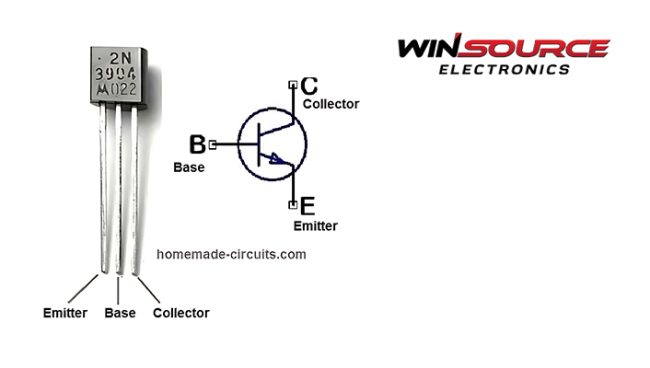
The 2N3904 is a ubiquitous NPN bipolar junction transistor (BJT) that has found its way into countless electronic circuits.
Understanding its capabilities and specifications is crucial for engineers, hobbyists, and anyone interested in electronics.
In our latest blog, our electronics experts here at WIN SOURCE will delve into the 2N3904 datasheet to unveil the hidden potential of this small yet powerful component.
Let’s take the mini answer into account before we head straight in.
Dive into the 2N3904 datasheet to uncover the potential of this ubiquitous NPN transistor. From pin configurations to electrical characteristics, this guide explores applications, operating conditions, and more, empowering engineers to maximize the transistor’s versatility in electronic designs.
Ok, so now let’s begin our exploration of this mini transistor.
Overview of the 2N3904
The 2N3904 is a general-purpose NPN transistor commonly used for amplification and switching applications.
Its small size, low cost, and reliable performance make it a staple in electronic design.
The data sheet is a comprehensive guide, providing crucial details about the transistor’s electrical characteristics, pinout, and recommended operating conditions.
Pin Configuration
Examining the pinout is the first step in understanding how to integrate the 2N3904 into a circuit.
The datasheet illustrates the three pins—Collector (C), Base (B), and Emitter (E)—and their respective functions.
A clear grasp of these connections is fundamental for successful circuit design.
Electrical Characteristics
The datasheet meticulously outlines the 2N3904’s electrical specifications, including parameters such as maximum collector current (IC), collector-emitter voltage (VCEO), and DC gain (hFE).
Engineers rely on these values to ensure the transistor operates within its specified limits, preventing potential damage.
Operating Conditions
For optimal performance, adhering to the recommended operating conditions outlined in the datasheet is essential.
Ambient temperature, power dissipation, and storage temperature can significantly impact the transistor’s functionality.
A thorough understanding of these conditions aids in designing robust and reliable circuits.
Amplification and Switching Applications
Explore the diverse applications of the 2N3904, ranging from simple signal amplification to acting as a switch in digital circuits.
The datasheet provides insight into the transistor’s capabilities in different scenarios, empowering engineers to make informed decisions based on their specific project requirements.
Example Circuits
The datasheet often includes example circuits showcasing how to use the 2N3904 in practical applications.
Analyzing these circuits can offer valuable insights into design considerations, component selection, and performance optimization.
Transistor Characteristics
The datasheet delves into the 2N3904’s intrinsic characteristics, shedding light on parameters such as thermal resistance, saturation voltage, and cutoff frequency.
These details are pivotal for predicting the transistor’s behavior in different conditions and environments.
Engineers leverage this information to fine-tune their designs, ensuring optimal performance and reliability.
Frequency Response
The 2N3904 datasheet provides insights into the transistor’s frequency response for signal amplification applications.
Understanding how the transistor’s gain varies with frequency is crucial in audio and radio circuits.
Engineers can use this information to choose the right components and design circuits that meet specific frequency requirements.
Packaging and Marking
In addition to electrical specifications, the datasheet typically includes details about the transistor’s packaging and marking.
This information aids in proper identification and handling during the manufacturing and assembly processes.
Engineers and technicians can refer to these sections to ensure they work with the correct component and follow recommended handling procedures.
Alternatives and Complements
While the 2N3904 is widely used, the datasheet may also provide information about alternative or complementary transistors.
This can be valuable when availability or specific performance requirements dictate the need for substitutions.
Engineers can explore these options to find suitable alternatives without compromising their overall design.
Environmental Considerations
Modern electronics often require consideration of environmental factors.
The datasheet may include information about RoHS compliance, halogen-free status, and other environmental specifications.
This is particularly important for designs adhering to specific regulations or industries with stringent environmental standards.
Troubleshooting and Failure Analysis
In the unfortunate event of circuit malfunctions, the datasheet can be valuable for troubleshooting and failure analysis.
It may include common issues, recommended test procedures, and guidelines for diagnosing problems related to the 2N3904. This information empowers engineers to identify and rectify issues efficiently.
Exploring the 2N3904 Datasheet – To Finish On…
The 2N3904 datasheet is a comprehensive guide, offering a wealth of information beyond basic electrical specifications.
By exploring its various sections, engineers gain a deeper understanding of the transistor’s behavior. This enables them to design robust circuits, troubleshoot effectively, and make informed decisions throughout the product development lifecycle.
Whether you’re a seasoned professional or a curious enthusiast, the datasheet is an indispensable tool for harnessing the 2N3904 transistor’s true potential in electronic design.
For all your industry projects or even if you are a home electronics enthusiast, don’t forget to download our brochure or browse our store for high-quality electronics devices with the WIN SOURCE quality guarantee.
© 2024 Win Source Electronics. All rights reserved. This content is protected by copyright and may not be reproduced, distributed, transmitted, cached or otherwise used, except with the prior written permission of Win Source Electronics.

COMMENTS